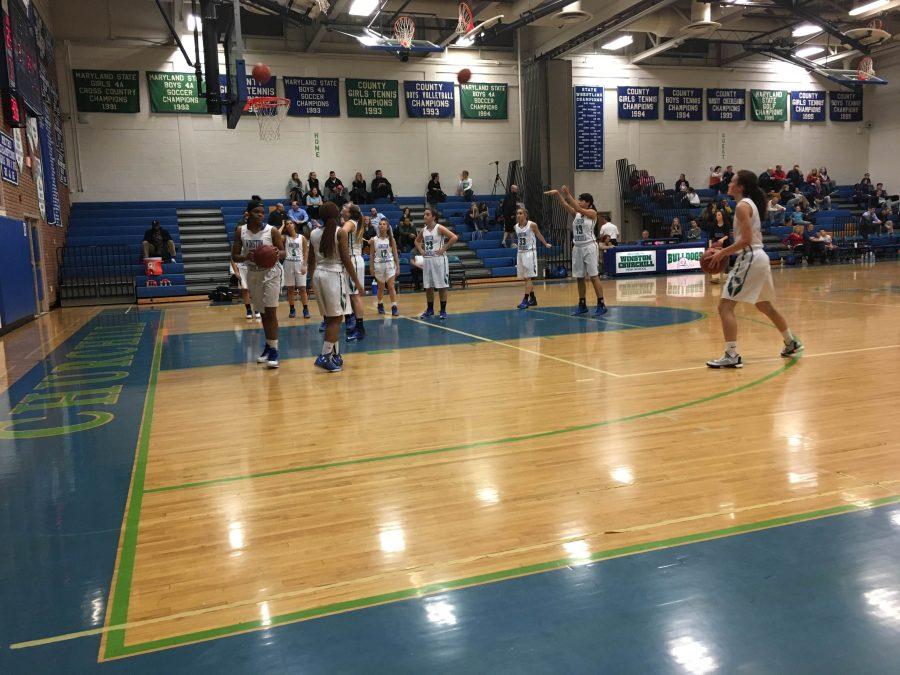Equal Processes Needed for All Sports Tryouts
The varsity girls basketball team warms up before the second half of their home game against Wootton. Head Coach Katelyn Blanken talks privately with each player to discuss the results of their tryout, whether or not she made the team.
January 9, 2017
High school sports have been glorified in American culture for decades. It seems almost essential that a student plays on a high school team to live true to the American experience.
In reality, not making the team is most definitely not the end of the world. Some are just more athletically inclined and others are not—in no way is this bad. There are multitudes of other non-athletic extracurricular activities at CHS to get involved in.
However, the way coaches let students know whether or not they made a team can greatly impact the students’ high school experience. For, what is more degrading to an adolescent than any sort of public humiliation or rejection?
CHS coaches should use a uniform procedure to notify students of the results of tryouts. Currently, there are many different ways teams conduct this procedure. While some methods are better than others, one uniform method of conveying tryout results would be beneficial to all student athletes.
According to girls varsity basketball coach Katelyn Blanken, the way coaches convey this information depends on different factors like what sport it is and how many people tried out.
Coaches inform students in a variety of ways, and thus there is no defining what is ‘painless’ and what is painful. Either way, getting rejected from a team will be painful for any hopeful student.
For instance, it can be incredibly humiliating and depressing when coaches publicly post a list with the names of students who make the team and those who do not. When many of their peers are celebrating, students who did not make the team are left upset.
Informing via list can be done more sensitively when accompanied by individualized communication.
According to varsity swim and dive coach Christopher Tappis, he prints out a list of the names of the students who make the team and posts it outside his classroom. To protect the feelings of the students who are cut, he emails them the night before to give the warning that they don’t need to search for their name on the list.
This is a nicer way of letting students know their fate because this prevents their eyes from frantically scanning a list searching for a name that isn’t there. Email is private and provides a more personal and less humiliating way of letting down those who did not make a team. However, their friends and the other people who tried out for the team will see the list and know who made it and thus who did not make it.
According to Blanken, she talks to each girl personally to tell them the results of the tryouts.
This method is better yet because it is more personal and intimate for the students, and they are informed of why they did or did not make the team. It also shows that the coach is fully invested in the player’s well-being, as they take the time to actually talk to them individually. Although, for teams who have a large number of students tryout, this method is extremely inconvenient and even impossible as there are too many students for the coach to talk to individually.
It is important for coaches to show students this kind of sympathy because it is difficult for teenagers to accept rejection and reach closure without a more personal, private explanation. It’s especially crucial due to high schoolers’ pre-existing, immense academic stress. Add on the humiliation of feeling below a student’s peers outside of the classroom, and the result is an emotional disaster.
A coach or student might argue that it doesn’t make a difference how coaches convey tryout results to students because rejection is part of life and students should get used to it.
While this is a valid argument, it’s also important to soften the blow for those who get rejected.
Teenagers are highly susceptible to emotional instability and depression, and being cut from a team can easily trigger a loss of self-esteem. The best way to do this is through a privatized email or conversation between the coach and student in order to protect the student from humiliation or depression. Even a simple sort of rubric where a coach can clearly list the reasons why the student did not make the team would provide adequate closure and be effective.
According to athletics department director Jesse Smith, in his opinion, the best way to convey tryout results is by talking to the student and letting them know exactly why they were cut from the team and then explaining what they need to improve upon.
Although, according to Smith, he does not want to establish a definite policy to inform students of tryout outcomes because he trusts that each of his coaches are professional and experienced enough that they do not need him to regulate the way they conduct their tryouts. In addition, since each sport is different, all he asks is that all the coaches are respectful at all times and that they always provide an adequate explanation to the student as to why they did not make the team.
Regardless of the sport, it is still possible to devise a uniform way for coaches to convey tryout results to students—and CHS needs to do just this.


